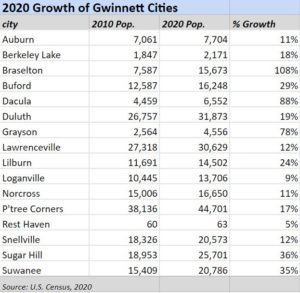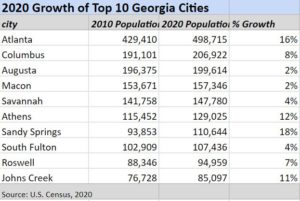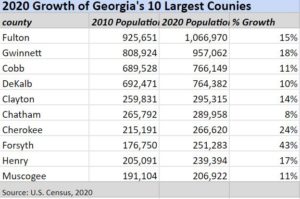By Elliott Brack
Editor and Publisher, GwinnettForum
AUG. 17, 2021, Exclusive in GwinnettForum | The 2020 Census results show that Gwinnett County continues to grow, now with a population of 957,062, an increase of 148,138 people or 19 per cent since the 2010 census. Gwinnett continues to be Georgia’s second most populated county, trailing Fulton County, which has 1,066,970 people.
![]() The state of Georgia now has a population of 10,711,908, eighth largest state in the nation. However, 6,089,815, or 57 percent, of Georgia’s population resides in Metropolitan Atlanta.
The state of Georgia now has a population of 10,711,908, eighth largest state in the nation. However, 6,089,815, or 57 percent, of Georgia’s population resides in Metropolitan Atlanta.
Among Gwinnett cities, Braselton has seen the highest growth rate, an increase of 108 percent since 2010. It now boasts 15,673 residents. Among smaller cities, Dacula is up 88 percent to 6,552 residents, while Grayson has grown 78 percent, now counting 4,556 citizens.
 Peachtree Corners is the largest city in Gwinnett, with 44,701 residents, while Duluth has overtaken Lawrenceville as the second largest city, with a population of 31,873. Lawrenceville is close behind with 30,629 people.
Peachtree Corners is the largest city in Gwinnett, with 44,701 residents, while Duluth has overtaken Lawrenceville as the second largest city, with a population of 31,873. Lawrenceville is close behind with 30,629 people.
Sugar Hill is now Gwinnett’s fourth largest city, with a 36 percent growth, counting 25,701 residents. Suwanee is next largest, with 20,786 citizens, while Snellville follows closely behind, now with a population of 20,573.
Statewide, Atlanta continues as the largest city, growing a healthy 16 percent to 498,715 residents. Columbus has replaced Augusta as the second largest city, 206,922, compared to 199,614 for Augusta. However, growth around Augusta makes it the second largest metropolitan area, with a population of 611,000, nearly doubling the metro Columbus area population of 328,883. Savannah’s metro area is third largest at 404,798.
 Among the largest cities, Sandy Springs showed the most growth, 18 percent, now counting 110,644 residents. Warner Robins missed the top 10 with a population of 80,121, now 11th largest.
Among the largest cities, Sandy Springs showed the most growth, 18 percent, now counting 110,644 residents. Warner Robins missed the top 10 with a population of 80,121, now 11th largest.
Among the top 10 Georgia counties, Forsyth County has seen a large growth, 43 percent, with 251,283 residents, remaining just below Cherokee County, with 266,620 population. Cherokee’s growth was 24 percent.
Cobb County edged past DeKalb County as Georgia’s fourth largest county, while Clayton County replaced Chatham County as the fifth largest.
New in the top ten counties is Muscogee County, with 206,922 people, replacing Richmond County with 203,368, now 11th. Hall County is now just shy of the top 10 counties, having 203,136 people, or a growth of 14 percent.
The county with the biggest growth in Georgia for the 2020 census is Bryan County, near Savannah, up 48 percent to a population of 44,738. Forsyth County has the second fastest growth at 43.2 percent.
 Other counties with fast growth include Oconee, 41,799 (27 percent); Columbia, 156,010 or 26 percent; Jackson County, 75,907 or 26 percent; Cherokee, 266,620 or 24 percent; Effingham, 64,769 or 24 percent; Barrow, 83,505, up 20 percent; Dawson, 26,798, an increase of 20 percent; and Towns County, 12,493, or 19 percent.
Other counties with fast growth include Oconee, 41,799 (27 percent); Columbia, 156,010 or 26 percent; Jackson County, 75,907 or 26 percent; Cherokee, 266,620 or 24 percent; Effingham, 64,769 or 24 percent; Barrow, 83,505, up 20 percent; Dawson, 26,798, an increase of 20 percent; and Towns County, 12,493, or 19 percent.
The suburban counties of Savannah, Bryan and Effingham Counties, are the only South Georgia counties with fast growth. The only other counties in the top ten which are not in the near Metro Atlanta area are Columbia County, near Augusta, and Towns County, in far North Georgia.
For Gwinnett, the census shows the county continues a high growth rate, with an average of 14,813 new people moving in each year for the last 10 years. That means Gwinnett’s new growth alone each year is larger than the population of 49 Georgia counties.
- Have a comment? Send to: elliott@brack.net










Follow Us